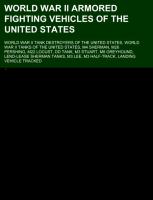- Start
- World War II armored fighting vehicles of the United States
World War II armored fighting vehicles of the United States
Angebote / Angebote:
Source: Wikipedia. Pages: 79. Chapters: World War II tank destroyers of the United States, World War II tanks of the United States, M4 Sherman, M26 Pershing, M22 Locust, DD tank, M3 Stuart, M8 Greyhound, Lend-Lease Sherman tanks, M3 Lee, M3 Half-track, Landing Vehicle Tracked, M18 Hellcat, Tanks of the U.S. in the World Wars, M24 Chaffee, M4 Sherman variants, T17 Armored Car, M10 tank destroyer, T28 Super Heavy Tank, M2 Medium Tank, M6 heavy tank, M2 Light Tank, T20 Medium Tank, M2 Half Track Car, M3 Scout Car, M7 Priest, M36 tank destroyer, M3 GMC, M29 Weasel, M6 Gun Motor Carriage, Marmon-Herrington CTLS, T29 Heavy Tank, M12 Gun Motor Carriage, Howitzer Motor Carriage M8, M40 Gun Motor Carriage, T18 Boarhound, T30 Heavy Tank, T14 Heavy Tank, Continental AV1790, M38 Wolfhound, T55E1 Motor Carriage, T27 Armored Car, T7 Combat Car, T40/M9 Tank Destroyer. Excerpt: The M4 Sherman, formally Medium Tank, M4, was the primary tank used by the United States during World War II. Thousands were also distributed to the Allies, including the British Commonwealth and Soviet armies, via lend-lease. In the United Kingdom, the M4 was named after Union General William Tecumseh Sherman, following the British practice of naming their American-built tanks after famous American Civil War generals. Subsequently the British name found its way into common use in the U.S. The Sherman evolved from the Grant and Lee medium tanks, which had an unusual side-sponson mounted 75 mm gun. It retained much of the previous mechanical design, but added the first American main 75 mm gun mounted on a fully traversing turret, with a gyrostabilizer enabling the crew to fire with reasonable accuracy while the tank was on the move. The designers stressed mechanical reliability, ease of production and maintenance, durability, standardization of parts and ammunition in a limited number of variants, and moderate size and weight. These factors made the Sherman superior in some regards, to the earlier German light and medium tanks that had swept across Europe in the blitzkrieg campaigns of 1939-41, and which still made up the majority of the German armor --albeit usually in up-gunned and up-armored variants-forces in the later stages of the war. The Sherman ended up being produced in large numbers and formed the backbone of most Allied offensives, starting in late 1942. The original Shermans were able to defeat the relatively small German tanks such as the Panzer III and IV they faced when first deployed in North Africa. Later, they found themselves more evenly matched against the newer up-gunned and up- armored Pz.Kpfw. IV medium tanks. They were outmatched by the Panther heavy tank and wholly inadequate against the armor and range of the Tiger I and later Tiger II heavy tanks, suffering high casualties against their heavier armor and more powerful 88 mm cannons. Mobili
Folgt in ca. 5 Arbeitstagen
